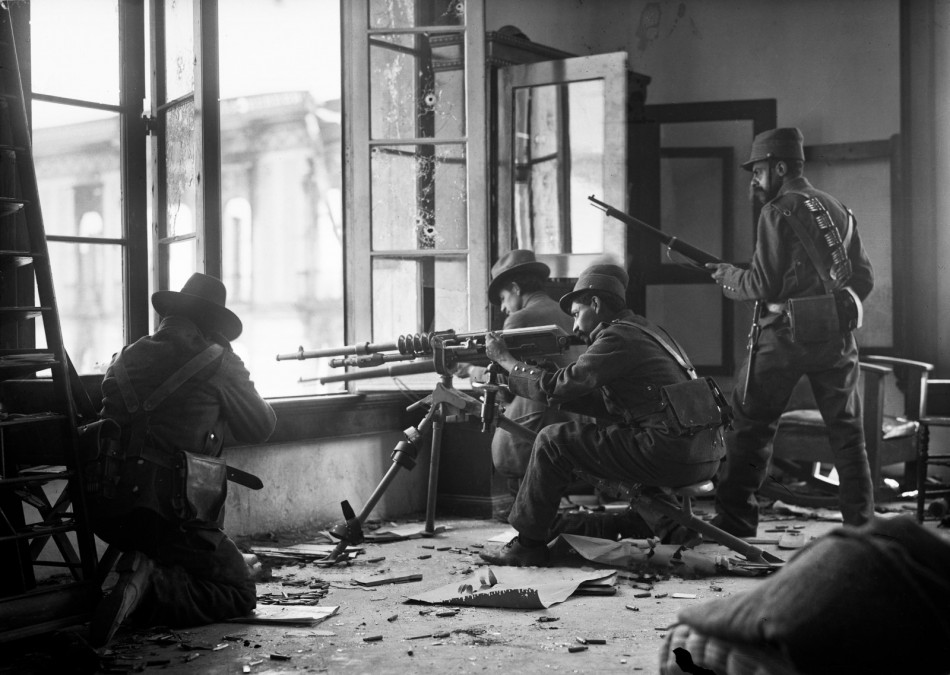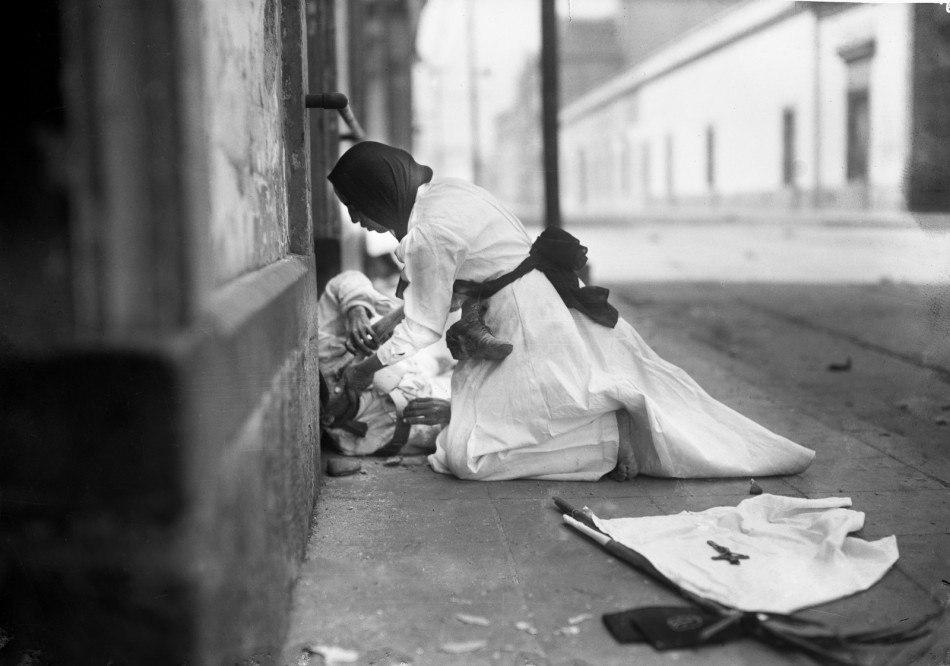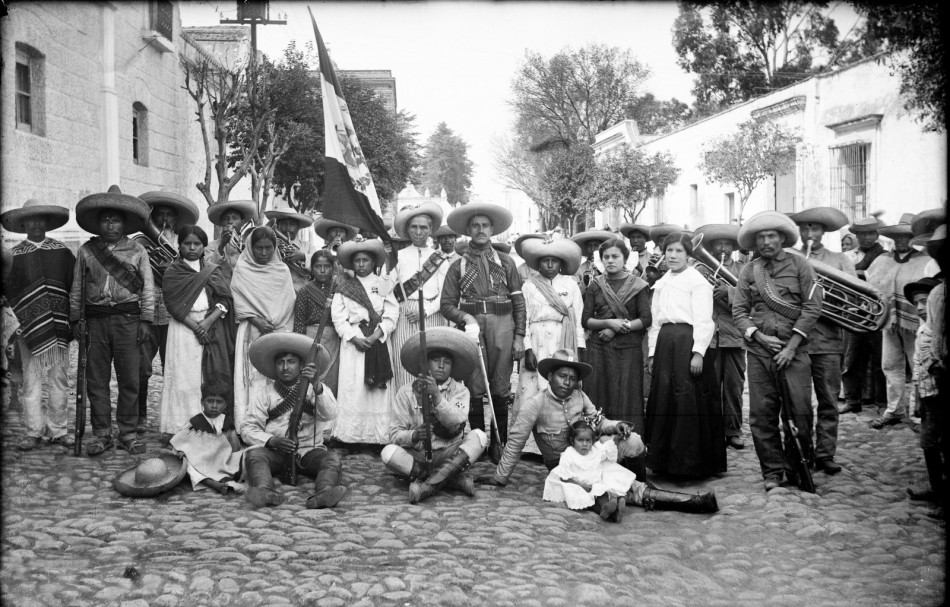
Sabino Osuna, "Felicistas in the YMCA," ca. 1910-1914, photograph, courtesy of Sweeney Art Gallery and Special Collections Library, University of California, Riverside.
How to View the Mexican Revolution
In the photograph “Felicistas in the YMCA,” snipers crouch near a window in a rubble-strewn room and train their weapons on the street below, and yet, the title informs us, this violent scene takes place in a former community center.
The photograph appears in the exhibition Mexico at the Hour of Combat: Sabino Osuna’s Photographs of the Mexican Revolution, on view at the University of New Mexico’s Maxwell Museum of Anthropology. It defies an otherwise chronological and thematic structure following the revolution and developments in Osuna’s photography. Located at the entrance of the exhibition, the image reveals a curatorial strategy to make the subject of the Mexican Revolution accessible for a US viewership. Some Americans may not recognize the names of revolutionary leaders Pancho Villa or Emiliano Zapata, but they know the YMCA, and likely experience the shock of seeing a familiar community center occupied by gunmen.
Mexico at the Hour of Combat shows, for the first time, a group of documentary photographs from UC Riverside Libraries Special Collections and Archives. This collection comprises 427 glass negatives of Sabino Osuna’s documentary photographs of the Mexican Revolution, 56 of which have been selected for inclusion in the exhibition. The show includes compelling portraits of key figures of the Revolution, as well as powerful documentation of the brutal violence of the war, and images constructed to craft a new Mexican identity.
As a whole, the exhibition importantly works to combat the under-representation of Mexican arts in U.S. cultural institutions, and seeks to draw attention to the Mexican Revolution as an important player in our understanding of revolution and resistance today. However, perhaps as interesting as the photographs themselves are the traces of the institutional presence of UC Riverside and of UNM within the exhibition.
Midway in the exhibition, a text panel explains curators Tyler Stallings and Ronald Chillcote’s decision to prioritize “Felicistas at the YMCA.” This text, titled “War Photography and the Osuna Collection,” contemplates the power of photography in shaping the cultural memory of historic events, and invokes Joe Rosenthal’s photograph of the raising of the flag at Iwo Jima as an example. Further, the text expresses the hope that the exhibition of Osuna’s photographs will help carve a place in the collective imaginary for the Mexican Revolution. While the text does not directly refer to “Felicistas at the YMCA,” this photograph is clearly meant to become just such an iconic image as the text describes: It is the only image which appears on UC Riverside’s online announcement for the show, and it occupies the most prominent place in the exhibition.
The construction of this image as the iconic record of the Mexican Revolution reveals the particularly American perspective of the academic institutions involved in the exhibition. The Felicistas were a relatively minor and ineffective counterrevolutionary force, and thus, probably not the most important group to memorialize in history. And yet, rather than selecting an image of one of the major revolutionary leaders or an important event to promote as the iconic image of the revolution, the curators selected the image that would be most accessible to American viewers.
Despite the fact that academic institutions tend to foster a critical awareness of the entrenched power of the nation-state, the institutions themselves are enmeshed in those very structures of power and control. Archives, in particular, have a history of participating in the control of knowledge through the collection and systematic organization of information and materials collected from various cultures and nations, but available only to a privileged few.
The construction of the Felicistas photograph as the primary representation of the Mexican revolution is one example of this institutional presence in the exhibition. In addition, the exhibition promotes the university’s extensive scholarly resources concerning the Mexican Revolution, thus constructing the Revolution as an object of study more than a complex historical event with continuing significance. For example, one display promotes the David Craven papers as a valuable resource available to students at UNM.
The title of this section, “¡Viva la Revolución! The Legacy of the Mexican Revolution at UNM,” is particularly troubling. While it is admirable that primary source documentation of the revolution is available to UNM students, appropriating a revolutionary cry to describe the institutional collection of these materials conflates scholarly interest in the Mexican Revolution with political solidarity for the movement. Also, by promoting the university’s research materials, the exhibition serves to construct the Mexican Revolution primarily as an object of study, firmly situated in the past, and further, catalogued, categorized and accessible through the university’s extensive resources.
However, it is equally important to recognize that, at times, the exhibition does point to a more complex context for Osuna’s work, and shows the revolution to be a massive societal restructuring with important consequences. In particular, there is a small display designed by faculty from UNM’s department of Chicana and Chicano studies that promotes a realignment of perceptions of both the Mexican Revolution and current US-Mexico immigration policies. The accompanying text explains that the revolution was a productive rather than a destructive process. This collective effort instigated important developments for Mexican society, which was later undermined by US-influenced policy.
Similarly, several texts included within the exhibition itself argue that the Mexican Revolution continues to reverberate in the way we conceive of revolution and resistance in the collective imaginary, and has particular relevance for contemporary grassroots movements. This line of thinking is most notable in a display of contemporary items of culture that celebrate the revolution, as well as the accompanying text panel, which cites the revolution as an influence and source for those protesting the forced disappearance of 43 students from Guerrero.
Although traces of institutional control haunt this exhibition, it nevertheless encourages the contemplation of the oft-ignored revolution’s significance through Osuna’s striking images. And, while “Felicistas in the YMCA” may not be appropriate as the iconic image of the Mexican Revolution, other examples of Osuna’s work, such as “A People’s Army: Soldiers, Soldaderas, and their Children,” or “Giving water to a wounded man,” would certainly be excellent contenders.

Sabino Osuna, “Nurse Aiding Fallen Soldier,” ca. 1910-1914, photograph, courtesy of Sweeney Art Gallery and Special Collections Library, University of California, Riverside.

Sabino Osuna, A People’s Army: Soldiers, Soldaderas, and their Children, ca. 1910-1914, photograph, courtesy of Sweeney Art Gallery and Special Collections Library, University of California, Riverside.
